|
The Data Body on the Dissection Table. Arts, Humanities, Medicine and Complex Network
THE DATA BODY ON THE DISSECTION TABLE
Arts, Humanities, Medicine and Complex Networks
Evening Event
Leonardo/Olats – Medical Museion
June 4 th 2013
Copenhagen, Denmark
6:30 – 9 pm
Dissection reveals what lies beneath the skin, but for a brief moment in time, and for a priviledged few. Depictions, models, and preservations have long been used to share what dissection uncovers; from ancient anatomical drawings to today’s virtual 3D anatomies.
In the 18th Century skinned “écorché” figures and anatomical waxes were constructed to reveal systems of interlocking bones, balanced pairs of muscles, and delicately entangled traceries of nerves and blood vessels. The Anatomy Lesson by Rembrandt, and the écorché The Horse Rider by Honoré Fragonard are famous examples at the border between medicine, science and art.
Contemporary medical sciences reveal ever more about the complex systems of the human body – but at a barely perceptible level. The (medical) human body today is understood, tested, and treated as a huge system of data, including complex interactions between our genetic material, our environment, and our host of microbial companions.
How do we grab hold of this data? How do we make sense of it and communicate it to others? How do contemporary artists and designers give our ‘data body’ material form through images, sound, and touch? What kind of tools are complex networks science proposing, and what kind of body do they reveal?
The Data Body on the Dissection Table brings together scientists, artists, philosophers, and designers to explore these questions, through roundtable presentations and audience discussion. The event takes place in Medical Museion’s auditorium - the Danish Royal Academy of Surgeons’ former anatomical theater.
Speakers include Albert-László Barabási , Distinguished Professor and Director of Northeastern University Center for Complex Network Research, Boston; François-Joseph Lapointe, Professor at the Biological Sciences Department, University of Montreal and Artist; Annamaria Carusi, Associate Professor in Philosophy of Medical Science and Technology at the University of Copenhagen and Jamie Allen, Artist and Head of Research at CIID/Copenhagen Institute of Interaction Design.
The event is co-organised by Leonardo/Olats and Medical Museion under the EU Studiolab framework, and in conjunction with the Leonardo Day "Arts, Humanities and Complex Networks" satellite event for NetSci 2103.
Attendance is free within the seat limits, refreshments provided.
Registration: http://medm.us/databody
Date: Tuesday, June 4th 2013
Time: 6:30 – 9 pm
Venue: Medical Museion, Bredgade 62 DK-1260 Copenhagen K
http://www.museion.ku.dk/address
GALERIE
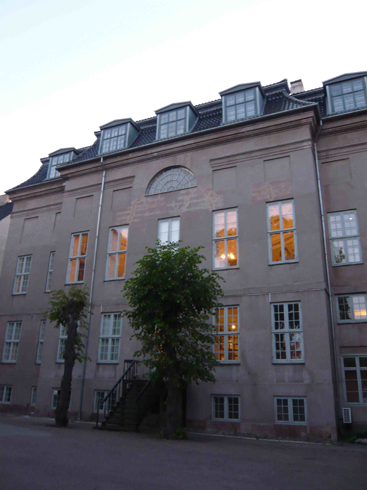 The Medical Museion, Copenhagen with the anatomical theater lit up
The Medical Museion, Copenhagen with the anatomical theater lit up
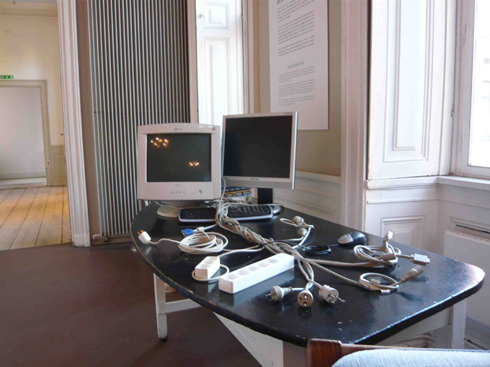 Anatomical theater, Medical Museion, Copenhagen, the "instruments are ready for the "dissection""
Anatomical theater, Medical Museion, Copenhagen, the "instruments are ready for the "dissection""
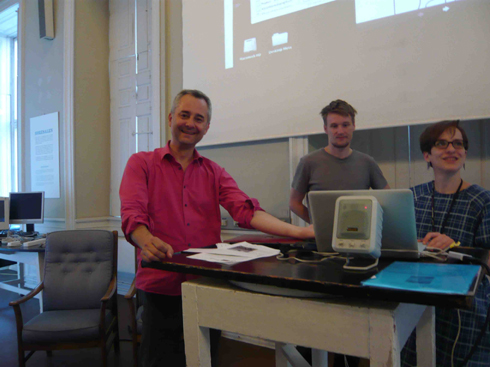 "Bit transfusion" with Albert-László Barabási, Lasse Frank and Louise Whiteley
"Bit transfusion" with Albert-László Barabási, Lasse Frank and Louise Whiteley
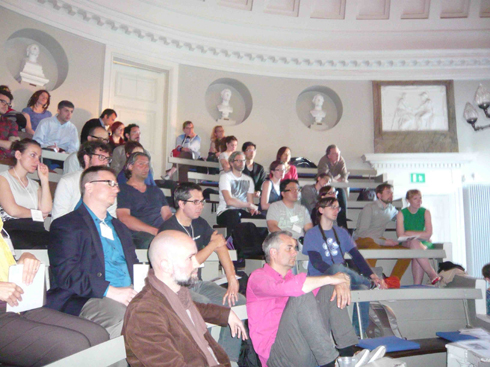 The audience, on the first row, Jamie Allen and Albert-László Barabási
The audience, on the first row, Jamie Allen and Albert-László Barabási
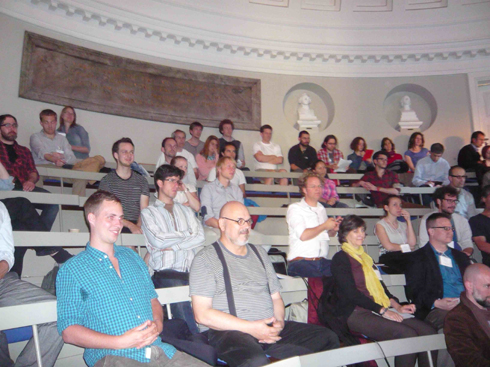 The audience
The audience
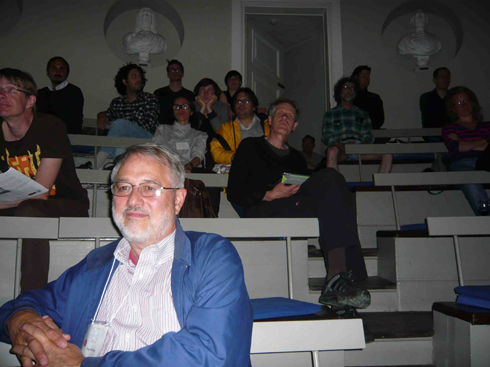 The audience with Roger Malina and Thomas Söderqvist
The audience with Roger Malina and Thomas Söderqvist
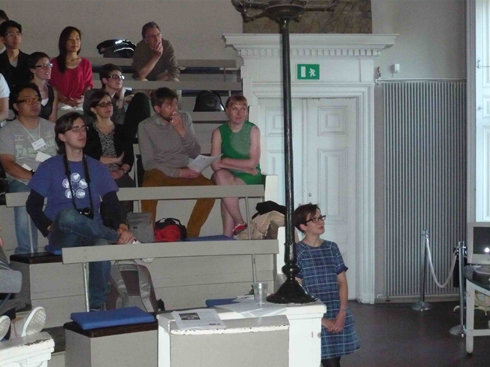 The audience, with Louise Whiteley
The audience, with Louise Whiteley
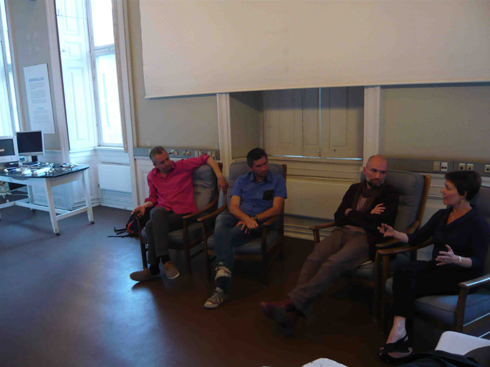 The panelists : Albert-László Barabási, François-Joseph Lapointe, Jamie Allen, Annamaria Carusi
The panelists : Albert-László Barabási, François-Joseph Lapointe, Jamie Allen, Annamaria Carusi
PROGRAMME
6:30 – 7:00 pm :
Museum open for visit of the exhibitions
7:00 – 8:30 pm
Welcome introductions:
- Louise Whiteley, Assistant professor in medical science communication at Medical Museion, Introduction for the Medical Museion
- Annick Bureaud, Director Leonardo/Olats, Introduction for Leonardo/Olats
- Roger Malina, Distinguished Professor of Art and Technology, University of Texas Dallas, Introduction for the Leonardo Day at NetSci: Arts, Humanities and Complex Network
Round Table
Moderator, Max Schich, Associate Professor, University of Texas Dallas and organizing chair of the Leonardo 'Arts, Humanitites and Complex Networks' at NetSci
- Albert-László Barabási, Distinguished Professor and Director of Northeastern University Center for Complex Network Research, Boston, Networkology, Thinking in Network Terms.
- Annamaria Carusi, Associate Professor in Philosophy of Medical Science and Technology at the University of Copenhagen, Getting Hold of the Digital Patient
- Jamie Allen, Artist and Researcher, Head of Research CIID/Copenhagen Institute of Interaction Design, Our Data Doppelgängers. Using creative practice to reflect on what data reveals
- François-Joseph Lapointe, Professor at the Biological Sciences Department, University of Montreal and Artist, Metagenomic Art: A Family Portrait
Discussion
8:30 – 9:00 pm :
Refreshments and snacks, exhibitions open
PARTICIPANTS
Speakers
|
Jamie Allen, Artist and Researcher, Head of Research CIID/Copenhagen Institute of Interaction Design, Copenhagen, Denmark
http://ciid.dk/research/people2/jamie-allen
 Article PDF Article PDF
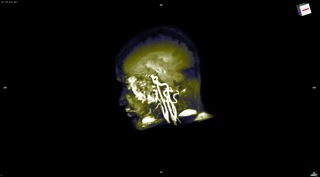
|
Jamie Allen (b. Canada, 1976) is an artist and researcher, Head of Research at the Copenhagen Institute of Interaction Design (CIID). His short talk touches on the topic using examples of practice-based projects and creative works from CIID and the international interaction design community. |
Our Data Doppelgängers. What creative practice with and from data reflects and reveals
Data can be gathered and presented in ways that clarify and inspire, but also in ways that obscure and confuse. In many creative practices that engage with technology, data plays a central role in as a medium for aesthetics, motivating and justifying arguments, and even sanctioning design and policy decisions. But data, appearing at first objective and ‘quantified,' often misses out key aspects of experience and reception - everything is more ‘qualitative’ than it first appears. Data visualization and user-study data-collection provide two points of (data?) entry for conceptual and practical design, artistic practice and new media work, that reflect the data body back to us. Through this mirroring, data as media mirrors material, cultural, and experiential aspects of human experience, from new perspectives of interiority and exteriority but in ways we have all seen before. These reflections do not in fact suggest a paradigm shift or a new data-driven, quantified era, but usefully serve to reflect instructive insights of a ‘data body’ that has been there all along.
|
|
|
Albert-László Barabási, Distinguished Professor and Director of Northeastern University Center for Complex Network Research, Boston, Massachusetts, USA
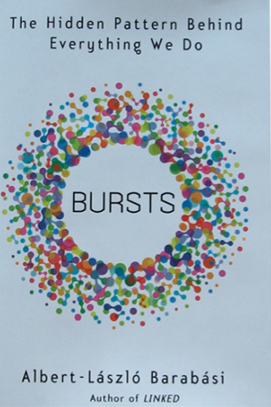
|
Albert-László Barabási is a Distinguished University Professor at Northeastern University, where he directs the Center for Complex Network Research, and holds appointments in the Departments of Physics, Computer Science and Biology, as well as in the Department of Medicine, Harvard Medical School and Brigham and Women Hospital, and is a member of the Center for Cancer Systems Biology at Dana Farber Cancer Institute. Barabási's latest book is Bursts: The Hidden Pattern Behind Everything We Do (Dutton, 2010). He has also authored Linked: The New Science of Networks (Perseus, 2002) and is the co-editor of The Structure and Dynamics of Networks (Princeton, 2005). His work led to the discovery of scale-free networks in 1999, and proposed the Barabási-Albert model to explain their widespread emergence in natural, technological and social systems, from the cellular telephone to the WWW or online communities. | Networkology, Thinking in Network Terms
|
|
Annamaria Carusi, Associate Professor, Centre for Medical Science and Technology Studies, University of Copenhagen, Denmark
http://www.annamariacarusi.me
| I study the way that computational technologies are involved in medical research, particularly: the social infrastructure for science in cyberinfrastructures, the construction of computational models and simulations of biological and physiological processes, and the role of computational displays and processing of images and other visualisations. I'm interested in the multiple ways that these supposedly abstract and disembodied computational networks, methods, tools and techniques are hooked up to material things. |
Getting Hold of the Digital Patient
The Digital Patient project aims to produce a “super-sophisticated computer program that will be capable of generating a virtual living version of yourself”, which can then be used to simulate treatments and predict the future (www.digital-patient.net). This seems to promise radical changes in personalized medicine, but what kind of a thing is this ‘digital patient’? A programme that is virtual, yet lives, and is a version of you? My talk will dissect the concept of the digital patient and the images used to promote it, focusing on how it combines ideas about both material and immaterial things – data, programmes, in silico and in vivo laboratory processes, virtuality and reality, and, course, you.
|
|
|
François-Joseph Lapointe, Professor at the Biological Sciences Department, University of Montreal and Artist, Montréal, Québec, Canada
 Article PDF Article PDF
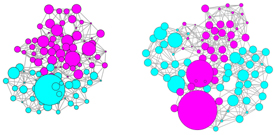
Metagenomic family portraits of real-life couples who have been living together for a few months or many years. Males and females are respectively depicted by nodes in blue and pink.
| François-Joseph Lapointe has a PhD in evolutionary biology from the Université de Montréal (1992) and a PhD in dance from the Université du Québec à Montréal (2012). As a scientist, he is interested in phylogenomics, population genetics and conservation biology. As a bioartist, he has transposed the stochastic processes of molecular evolution to the field of dance composition. For his most recent project, he is sequencing the human microbiome to create metagenomic family portraits. |
Metagenomic Art: A Family Portrait
Recent advances in high-throughput sequencing technologies and whole-genome sequencing have produced massive DNA datasets for a growing number of species. Metagenomics now makes available not only the genome of a single organism, but that of a community of species sampled directly from the environment. Namely, metagenomic research has been used to analyze and characterize the human microbiome – i.e., the collection of microorganisms living on our body and inside of it. Metagenomes are often depicted with complex networks displaying the similarities among microbial communities sampled at various body sites, or in different individuals. Here, I will present a framework for metagenomic art. I will use metagenomic networks to study the human microbiome, an artscience project focusing on real-life families. To do so, the oral microbiome of selected couples will be analyzed and compared with that of random individuals not living in the same household. I will further test the hypothesis that married couples who have been living together for a long time are more likely to have similar microbiomes than newlyweds. The corresponding networks will be displayed as metagenomic family portraits, a testimony of the intricate relationships among the metagenomes of individuals sharing microbes on a daily basis.
|
|
|
Organisers
|
|
| | |
|
|
|









